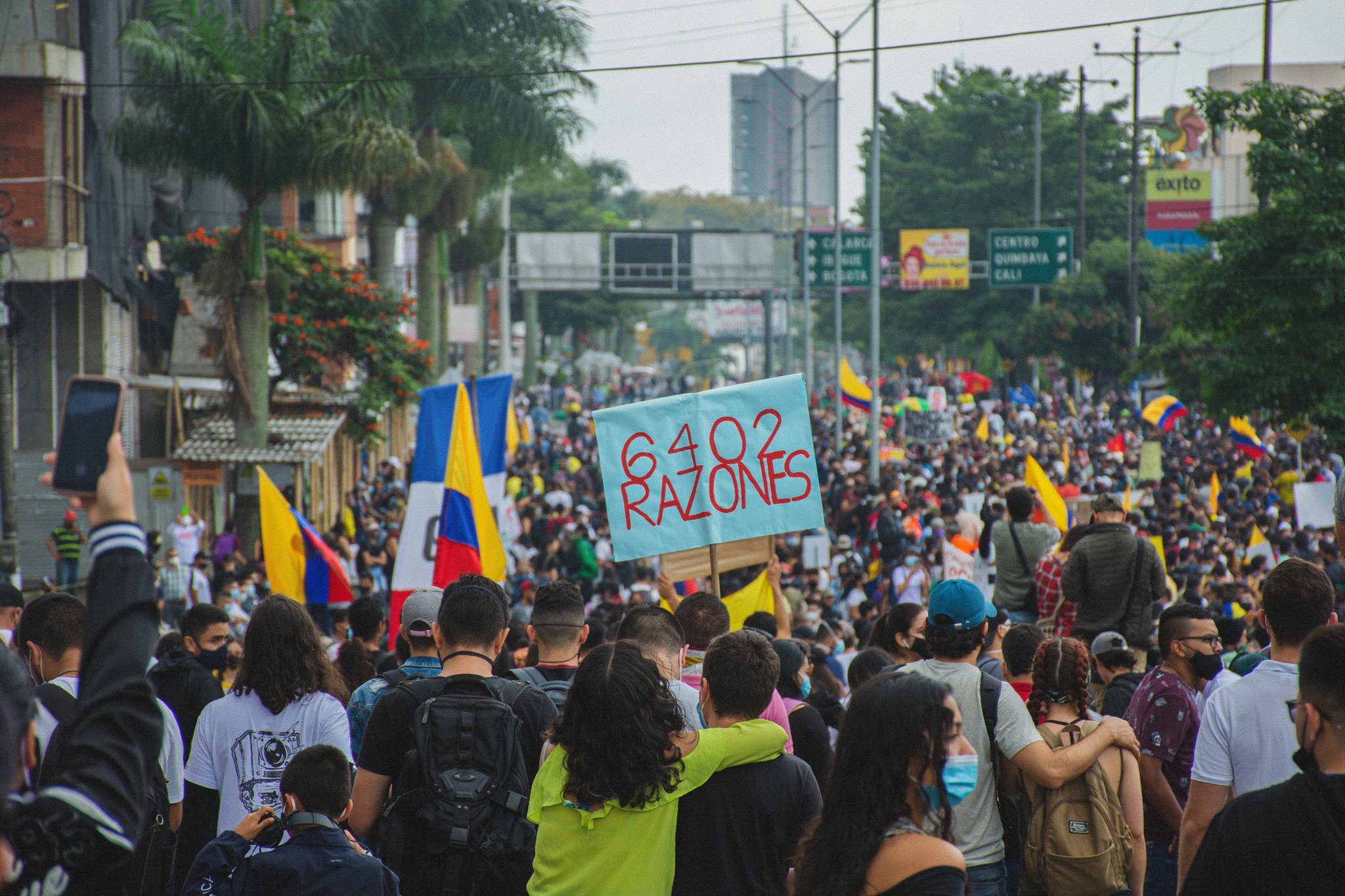We publish here an edited transcript of a lead-off by Jorge Martín (from the International Marxist Tendency) to the Latin American political education school on 28 May 2021. He analyses the situation in Latin America, which is mired in the COVID-19 pandemic and the capitalist crisis, with the masses erupting in social explosions in response. In his talk, he analyses issues such as the slogan of the Constituent Assembly, an evaluation of "progressive governments" and the role of the youth and women in the revolutionary movement that is gripping the continent. Events are moving very quickly, and in some cases have moved on from when this speech was delivered – but they only serve to confirm Jorge’s analysis.
Read the original in Spanish here |
Latin America has been the region of the world hit hardest by the pandemic from both a health and an economic point of view. According to official figures, Latin America has already reached a million deaths from COVID-19, but those figures are not accurate. Take, for example, the official figures for Mexico, which are about 200,000 deaths. But if we look at the excess number of deaths in relation to years prior to the pandemic, the number is 400,000: the vast majority of whom have died from COVID-19 but they have not been registered as such. In Peru, the official death toll from the pandemic is about 70,000, but the excess death toll is 180,000, more than double.
Although there are other countries where the figures are more in line with reality, if we look at the excess mortality figures from around the world, the leading countries are mostly from Latin America. Peru has an excess mortality of over 140 percent. Ecuador, Nicaragua, Bolivia, Mexico, Brazil, Colombia - practically all the countries that are in the top positions for excess mortality are from Latin America.
Also economically, this has been the region of the world that has experienced the greatest contraction: 7.7 percent of GDP as a whole, twice the world average, a figure that had not been reached since 1821, according to some bourgeois economists. In other words, in the entire history of independent Latin America, there has not been an economic contraction so brutal that has affected the entire continent. But not only that. In the period prior to this contraction, from 2015-19, economic growth in Latin America was 0.3 percent per year on average, that is, a five-year period of stagnation. And this stagnation meant a marked decline in the living conditions of the masses. Now we have a collapse of more than 7 percent.
All the contradictions of the pandemic and the world capitalist crisis are expressed in a more exacerbated way on the American continent. Extreme poverty levels have returned to the levels of the 1990s. It is estimated that the region's economy will not recover its 2019 level until 2024, that is, in another three years. And in my opinion, these economic forecasts, from ECLAC, from the World Bank, are quite optimistic, because they assume that the pandemic can be controlled, and the pandemic is not under control at all. Vaccination rates are very low across Latin America, and the policies of most governments are totally irresponsible, if not downright criminal. Even countries that at first carried out an effective restrictive quarantine policy and managed to control the pandemic, are now seeing the virus getting out of control.
The totally criminal policy that has been followed in relation to the pandemic, for example in Brazil, has now made that country a real breeding ground for all kinds of new variants of COVID-19, which are much more transmissible and ultimately deadlier.
It is not true that the economic crisis was caused by the pandemic, and in the case of Latin America we have shown with the figures that the capitalist crisis started before, at least five years ago. However, the pandemic, with its sudden and abrupt arrival, which paralysed economic activity, aggravates and exacerbates the economic crisis.
Since before the pandemic, Latin America was already experiencing a situation of enormous upheaval. It was not a situation of capitalist stability and bourgeois democracy, but an enormously turbulent situation that was expressed in its most acute form in the events of what we call the Red October of 2019. Some even speak of the “red year” of 2019, which culminated in the insurrectionary uprisings in Ecuador and Chile. In Ecuador, there was an unprecedented event: the government fleeing the presidential palace and abandoning the capital. And in Chile, events were perhaps even-more dramatic, although the government of La Moneda Palace (Chilean government headquarters) was not driven out, it was an insurrectional uprising that lasted for almost three months and could not be defeated by brutal repression.
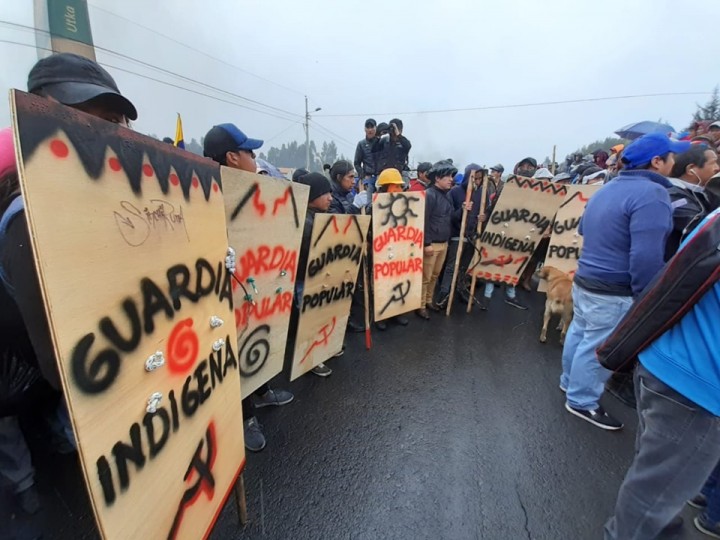 A knot is being retied with the struggles from 2019 / Image: public domain
A knot is being retied with the struggles from 2019 / Image: public domain
That is the situation we came from. Before the pandemic, there was enormous social polarisation and acute contradictions. This totally explosive situation is also connected with the world situation. Before the pandemic, we saw the revolutionary uprisings in Algeria, Sudan, Lebanon, Iraq, etc. And what was happening in Latin America, Haiti, Ecuador, Chile and even in Puerto Rico was part of that general process, with its own characteristics.
This capitalist crisis has dealt a very hard blow to the workers, the peasants, the masses, especially for those who work in the informal sector of the economy, and for the youth. But not everyone has lost out. The latest figures that have just been published indicate that, from 2019 until now, in Latin America, the number of dollar billionaires has gone from 76 to 107, most of them concentrated in Brazil and Mexico. And their accumulated wealth has gone from 284 billion to 480 billion dollars. In a year and a half, it has almost doubled. Most of us lose and yet a select few increase their wealth even in such a deep crisis.
It might seem, on the surface, that the abrupt arrival of the pandemic – which has put a halt on social life, makes physical contact difficult, and instills fear of contagion – had paralysed that revolutionary process that had started to develop, or at least had put it on pause. But even that pause did not last long. The masses of workers, peasants, indigenous people, youth, have no alternative but to continue fighting. In many countries, they have found themselves faced with a dilemma: go to work with the risk of being infected, which in many cases means a high risk of dying, or stay home and starve because they have no way of earning a living.
So we have seen that, even during the pandemic, in September last year there was the uprising in Bogotá and other cities in Colombia against violence and police killings, in which 40-50 neighbourhood police stations were burned down. In November 2020, huge mobilisations in Peru were a prelude to what is happening now. When parliament tried to remove President Vizcarra with an accusation of corruption, while the congressmen themselves are all corrupt, the people took to the streets, they did not buy into that manoeuvre. They came out, not to defend the government but to attack all politicians. There was a week of spontaneous demonstrations that forced the government out.
In Guatemala, around the same time, a protest against the budget cuts led protesters to set fire to the congress building. In March of this year we saw the uprising in Paraguay. In a situation of total despair, where people were dying, there were no medical supplies in the hospitals, people had to pay for their own supplies for COVID-19 hospitalisations, and a very high infection rate in a country that borders Brazil. When the people took to the streets, the Colorado Party government responded with repression, but the people confronted the police and at one point managed to prevail in the streets. And finally we come to 28 April of this year, with the start of the Colombian national strike.
In other words, we can say that the knot of the revolutionary mobilisation, which was already coming to the fore before the pandemic, is being retied. That it is not related to the pandemic itself, but the worsening of the social and economic conditions of the masses due to the pandemic make this mobilisation more urgent. What the pandemic has brought to light is the enormous wealth disparity, and the enormous corruption of bourgeois democracy on the continent where there has been scandal after scandal of politicians and businessmen who get vaccinated illegally before vaccines can reach the population. The destruction of public health systems over many years has left these countries totally exposed to such a pandemic.
Huge polarisation and discrediting of the institutions of bourgeois democracy
All this adds to the discontent that had already been accumulating, and creates a situation of enormous polarisation; a situation, furthermore, of enormous mistrust in all the institutions of bourgeois democracy. In many of these countries, the mobilisations have a common characteristic, which is the fight against corruption. In Peru, the last five presidents are all either in jail, or convicted or prosecuted for corruption. The spectre of "que se vayan todos”, (“get rid of them all") the slogan that mobilised the masses in the Argentinazo in 2001 (a political, social, economic and institutional crisis in which the slogan refers to removing all politicians from government), is once again haunting Latin America.
And this is what is reflected, for example, in the constituent elections in Chile where the majority of established parties have fared very badly. In the elections in Peru, a party that practically did not exist managed to get to the second round and now threatens to win the elections [and was ultimately successful - ed]. There is a very deep crisis of legitimacy of bourgeois democracy, to the extent that bourgeois democracy cannot solve any of the problems of the masses, and is correctly seen by the masses as totally corrupt institutions at the service of the rich, of the capitalists, and of the imperialist domination of these countries.
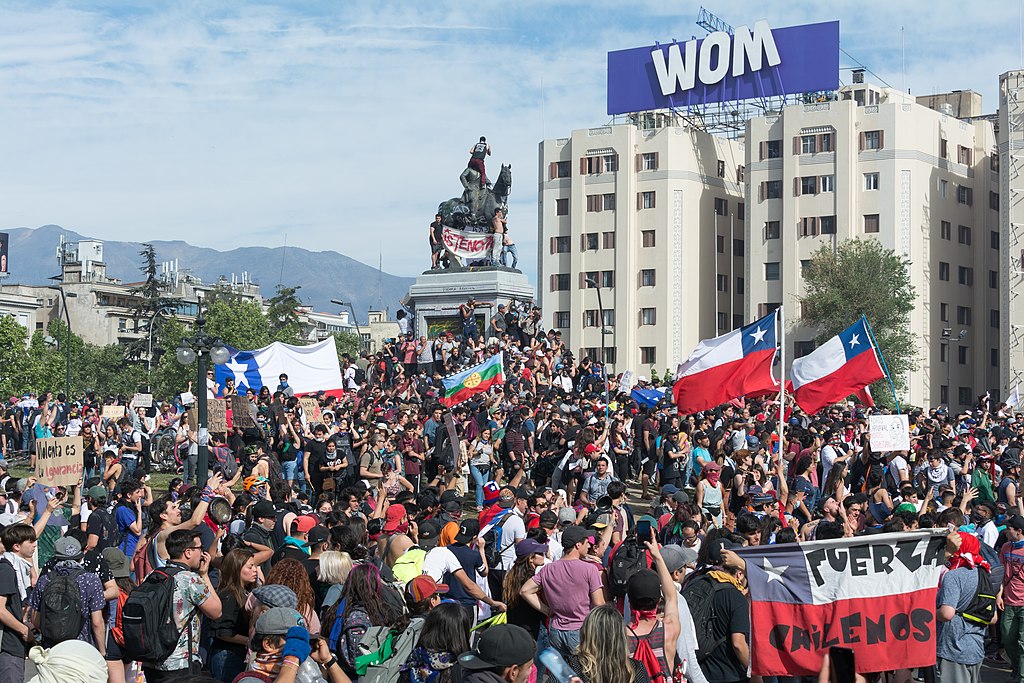 The bad results of known parties in the Chilean constitutional assembly elections is testament to the discrediting of the establishment / Image: Carlos Figueroa
The bad results of known parties in the Chilean constitutional assembly elections is testament to the discrediting of the establishment / Image: Carlos Figueroa
One of the most striking examples of these is the result of the elections to the constituent convention in Chile. These elections show firstly a very hefty defeat of the right-wing bloc, the government bloc that is currently totally discredited. But I also believe it is very significant that the parties of the old Concertación de Partidos por la Democracia (Coalition of Parties for Democracy) renamed Nueva Mayoría (New Majority) were defeated. This coalition included everything from the Communist Party to the Christian Democrats, but now the Socialist Party, Christian Democrats and other parties of this bloc are totally discredited in these elections. They cannot be presented as a replacement for the right-wing and they got really bad results that have caused them to enter into a very deep crisis.
But even beyond that, it must be seen that within what is the left, la Lista del Pueblo (the People's Slate), although in a slightly distorted or not totally clear way, is the slate that better or more directly represents the uprising of 2019. It has representatives of the social movements and of the popular assemblies, and it won practically the same result as the Apruebo Dignidad (Approve Dignity), which is the slate that includes the Communist Party and the Broad Front. These are two organisations that have a much-longer tradition than the People's Slate that was improvised in recent months and that have much more established militant roots, and that also got good results. It is significant that Apruebo Dignidad surpasses the ex-Concertación in number of votes and in number of constituents.
This rejection of all political parties is reflected in the fact that independent or supposedly independent candidates won the majority in the constituent convention. There is also the fact that abstention was very high, 58 percent, that is, participation was only 42 percent. Not even the idea of a constituent convention, the promise to change everything, to bin the constitution inherited from Pinochet, managed to enthuse important sectors of the population. They don't see that it will solve anything.
The struggle in Chile is not only expressed in the electoral field, it is also expressed in the field of mobilisation. A week before the elections, there was a strike in the ports and a threat of a general strike that forced the bourgeois institutions, in this case the constitutional court, to disavow the Piñera government on the issue of requiring the “third withdrawal.” The workers were demanding to be able to withdraw a third tranche of the money they have deposited in private pension funds. The government was against it, but the constitutional court clearly stopped it in its tracks to avoid a new social explosion. That is quite important.
The slogan of the Constituent Assembly
I think we have to pause for a moment to analyse this question of the constituent assembly. What does the constituent assembly mean in general and what does it mean in particular in this case in Chile? In Chile, it was a manoeuvre by the bourgeoisie, by the regime, to divert the attention of the masses during the 2019 uprising. Clearly, what was posed by the masses was the overthrow of the government, when Piñera was against the ropes, along with his government the whole regime. At that time, all the parties, from the Broad Front on the left to the parties that support Piñera's government majority, the Pinochetist right, met in a great National Agreement for Peace and they reached this idea of calling a constituent assembly. The only party that stayed out was the Communist Party, but it did not oppose the agreement either, although at least it did not sign the agreement.
Clearly what they wanted was to get the masses out of the revolutionary struggle in the streets that threatened to topple the entire regime and channel them into bourgeois parliamentarism, which is obviously much easier to control. And in practice, they have succeeded. To the extent that there was no revolutionary alternative, a leadership that would provide direction to the struggle, the masses have expressed themselves partially and in a distorted way through the elections.
But more generally, this question of the Constituent Assembly has been raised in many Latin American countries where there have been enormous upheavals. It is being raised in Peru and discussed in many other countries. This has two sides. The first is that, in general, a Constituent Assembly is a bourgeois parliament. It is a bourgeois democratic assembly that differs from a normal parliament only in that, instead of making laws in general, its task is to draw up a constituent law, that is, a new constitution.
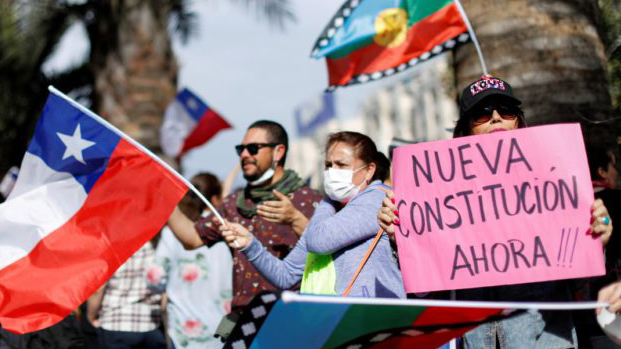 The bourgeois are using the constituent assembly to divert the Chilean struggle to safe channels / Image: MaldonadoCurti
The bourgeois are using the constituent assembly to divert the Chilean struggle to safe channels / Image: MaldonadoCurti
For the bourgeoisie, on some occasions the Constituent Assembly serves to rehabilitate the system, that is, to regenerate the legitimacy of the bourgeois democratic system. Or they might attempt to use it to this end. That is to say, faced with a situation in which the masses see all the current institutions as rotten, the ruling class says: we are going to discuss a new Constitution and everything is going to be much better and much more democratic and we are going to get the masses to trust in the system again.
However, from the point of view of the masses, on many occasions this demand expresses, in a distorted way, the idea that "we are going to change everything", "we have to change everything at the root, the whole system is rotten, and we need a new one.” The problem is that simply by writing a new constitution we are not going to change the underlying situation. It is not that a country like Chile or a country like Peru has an imperfect, undemocratic bourgeois democracy, inherited from dictatorships. That is a problem, but that is not the fundamental problem. Even if Peru, Chile, and Colombia had a "perfect" bourgeois democracy, the rulers would continue to be the same as always, the owners of the means of production. In Peru, CONFIEP (National Confederation of Private Enterprises) would continue to rule, in Chile Piñera and his millionaire friends and the big copper multinationals would continue to rule, and in Colombia the same oligarchy would continue to rule, based on large estates, linked to drug trafficking and other sectors of the bourgeoisie at the service of, and dominated by, US imperialism.
What then is our task? In the first place we have to try to explain the danger of the constituent assembly, of diverting a revolutionary mobilisation in the direction of bourgeois parliamentarism. But at the same time, we must connect with the healthy instinct of the masses who want to change everything, who want to sweep away the entire established regime. The fact that, in a country like Chile, there is a constitution written with the involvement of Pinochet; or that in a country like Peru there is a constitution written with input from Alberto Fujimori, is a scandal of great proportions. We are not opposed to fighting for democratic rights and freedoms. But we must explain that this struggle by itself does not solve the most acute problems of the masses, which are problems of poverty, hunger, misery, shelter, bread, and work.
Even a constitution that says everyone has the right to work and to a home, as long as the capitalist system continues to exist, does not mean that those rights become reality, just because they exist on a piece of paper. In recent years, Constituent Assemblies have been held in several Latin American countries: Ecuador, Bolivia, even Colombia (1991) and the truth is that these countries are still capitalist, and the large landowners, bankers, capitalists, and multinationals continue to control the economy.
For example, in Chile, during the uprising, we warned that we were not in favour of the slogan of the constituent assembly. We warned that it could be used by the regime, as it ultimately was. We raised a different slogan that had a different character and that would connect with those deep and democratic aspirations of the masses but that had a character of total defiance, to pose the question of who governs here: either the businessmen govern or the working class governs. The slogan that we raised more or less tentatively was that of a national assembly of the working people with delegates elected in the popular assemblies, in the open councils, of the people in struggle, in the trade unions, in the workplaces, among the youth. That is to say, a slogan that raised the question of dual power: here is the power of the bourgeoisie, in this rotten regime, and here is the power of the working class, the peasants, the poor, and the youth in struggle.
In other words, the slogan of a national assembly of the working class or a popular worker and peasant assembly. Or as we have said in Colombia, a national worker, peasant, and people’s emergency meeting: that is, of delegates elected in the factories, in the neighbourhoods, on the streets, among the youth, and among the peasants. Let those delegates meet and decide how we are going to take control of this country. This is a slogan of a soviet character, different from the slogan of the constituent assembly.
Finally, of course, although we have warned that this is a trap by the bourgeoisie, if the constituent elections are finally reached, our position is the same as toward any other bourgeois parliament. If the revolutionary movement does not have the strength to overcome bourgeois parliamentarism through the seizure of power, then it has the obligation to participate in those elections, without illusions, as a means of explaining the need for a revolutionary programme.
This is a discussion that is important to deepen because it will reappear in other countries.
Is the problem neoliberalism?
Another country where enormous class polarisation is expressed as a consequence of the capitalist crisis is Peru. In the presidential elections of 6 June we have, on the one hand, a candidate, Pedro Castillo, from Peru Libre, a party that defines itself as Marxist, Leninist, and Mariateguist, whom the oligarchy describes as ultra-leftist, “the candidate of Sendero Luminoso” (maoist group), “terrorist”, “Castro-Chavista ”, etc. And on the other, there is Keiko Fujimori, a right-wing demagogue, daughter of the dictator, who is not the political representative of the interests of the ruling class, but only of a part of it, although now all the capitalists have rallied behind her candidacy.
Pedro Castillo also rose to notoriety for his leading role in the 2017 teachers' strike, a strike that was held against the SUTEP union bureaucracy, controlled by Patria Roja. In other words, Peru Libre also stands in opposition to the two official communist parties, one that controls the leadership of SUTEP and the other that controls the leadership of the CGTP (General Confederation of Workers of Peru).
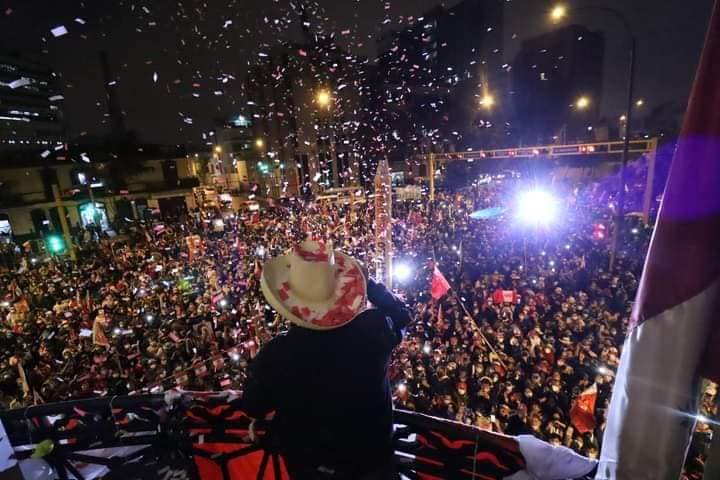 Despite what the likes of Castillo or AMLO say, the problem is not 'neoliberalism' or 'corruption', but capitalism / Image: fair use
Despite what the likes of Castillo or AMLO say, the problem is not 'neoliberalism' or 'corruption', but capitalism / Image: fair use
That a candidate with this profile, who entered the second round of the presidential elections almost by chance, is on the verge of winning the presidency, is an expression of the enormous discredit of all the parties and institutions of bourgeois democracy, a phenomenon that is common to many Latin American countries and rooted in the deep crisis of capitalism.
A recent poll in Colombia revealed that the disapproval of President Duque has reached historical records of 79 percent, although it still does not reach the levels of Piñera in Chile, who has the support of only 7 percent of the population. But what was even more astonishing is that only 5 percent of respondents in Colombia had a favourable opinion of political parties in general, and 90 percent had an unfavourable opinion.
That is, the fact that Pedro Castillo has massive support in the second round, despite all the attacks and his combative profile (in fact, his support in the polls has been decreasing as he moderated his message in the second round), is extremely significant and reflects the general rejection of the 1993 regime and the search for a radical alternative, the more radical the better.
However, the programme of Peru Libre, Castillo's party, suffers from the same defects as the programmes of the parties of the reformist left throughout Latin America, and it is the fact that they pose the solution of the serious problems that affect the masses within the limits of the capitalist system. The idea that "neoliberalism must be fought", as if neoliberalism were something purely ideological, and not the result of the deep capitalist crisis. García Linera in Bolivia would speak of developing, through the role of the state, an “Andean-Amazonian capitalism”. As if there were room, within the limits of capitalism, for a different policy. In the case of López Obrador in Mexico this is expressed in the idea that the problem is not capitalism but corruption. If the capitalists paid taxes and corruption was eliminated, everything would be wonderful and rivers of milk and honey would flow.
The Peru Libre programme clearly states that they are going to tackle the interests of the mining and energy multinationals but at the same time it calls for the collaboration of the "national" "productive" business community that must "pay taxes", etc. To quote directly: “New economic model of the state. Our party raises the people’s economy with markets, an aspect broadly addressed in the previous chapter. We are not against private companies as long as their activity benefits the majority of Peruvians”.
These responsible, productive businessmen, who have the national interest at heart, the sovereign development of the country... in reality they only exist in the imagination of the leaders of the reformist and nationalist left.
This policy is nothing more than a rehash of the Stalinist policy of the two stages. That is to say, first a national and democratic revolution in which we must collaborate with the progressive bourgeoisie and then later on we can talk about socialism. This policy has led to disaster in all those places where it has been applied. The national bourgeoisie in the epoch of imperialism is incapable of playing any progressive role, first because it is tied by a thousand threads to the interests of imperialism and of the landowners and cattle ranchers, and second because in reality any attempt to put itself at the head of the nation, mobilising workers and peasants, would pose a threat to its own regime of domination. That is something that Trotsky explained very well in The Permanent Revolution.
There is no progressive bourgeoisie anywhere. In Peru itself, we have seen how all sectors of the bourgeoisie have aligned themselves against Pedro Castillo, despite the fact that his programme does not go beyond the limits of the capitalist system.
Balance of "progressive governments"
The model of Peru Libre when preparing its economic programme is based on the governments of Evo Morales and Rafael Correa. I think it is important to talk about the balance of these governments, so-called “progressive governments” in Latin America, taking account of their differences and nuances, because not all these governments were the same or represented exactly the same thing. It is important to understand that these governments benefited from a cycle of high prices of raw materials that lasted roughly from 2003 to 2014. This gave them certain room for manoeuvre to be able to apply a policy of concessions to the masses and a series of social programmes, of health, education, etc. It was this cycle of high prices of raw materials in exporter countries that allowed a certain improvement in the living conditions of the masses and solidified or gave certain stability to these governments for about 10 years.
However, that was a rather peculiar period, the engine of which was the growth of the Chinese economy, and which is not necessarily going to be repeated. Around 2013-14, when commodity prices began to fall, all these governments ran into difficulties. They began to lose elections and they began to lose the support they had gained. We saw this in 2015 in Argentina and Venezuela, the referendum Evo Morales lost in 2016, and the huge drop in Dilma Rousseff's popularity after her re-election in 2014.
Here we see precisely the limitations of this idea of trying to carry out a policy in favour of the masses without breaking with the limits of capitalism. Using the income from natural resources to benefit the masses was possible in a limited way and for a very limited period of time. In reality, most of these governments fulfilled the function of re-establishing the legitimacy of the institutions of bourgeois democracy after periods of revolutionary convulsions.
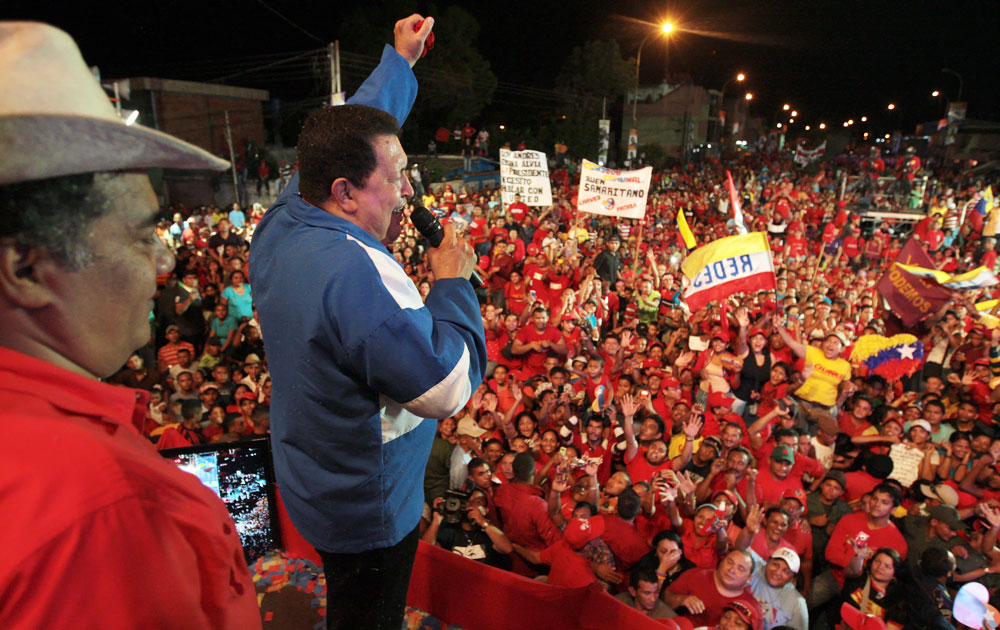 The last wave of progressive governments in Latin America ran into the limitations of carrying out reforms within capitalism using the high price of natural resources / Image: chavezcandanga
The last wave of progressive governments in Latin America ran into the limitations of carrying out reforms within capitalism using the high price of natural resources / Image: chavezcandanga
What is the perspective now, in view of the possibility of the arrival to power of similar governments in these current conditions? Those governments are going to find themselves with much less room for manoeuvre. They are not going to have 10 years of high raw material prices to be able to make some concessions. Instead, they are going to face a dilemma very quickly. Either they must confront the interests of the oligarchy, of capitalism, and of the multinationals to apply a policy for the benefit of the majority of the working class that has brought them to power, which in most cases they will not do, or they will be forced to apply a policy that will pit them against their own social base.
This is going to be a necessary experience, a necessary school that the masses in these countries will have to go through to the extent that there is still no revolutionary alternative that can dispute the leadership of the movement, and that is our task.
In this sense, and since we are talking about Peru, it is interesting to see what Mariátegui said, because poor Mariátegui is claimed by many, in academia, in the “progressive” left, and in this case in Peru Libre. Boric in Chile also recently quoted him by saying that the movement had to be “neither tracing nor a copy, but heroic creation”. That's what they always quote from Mariátegui, but they forget about the other part of the quote! Mariategui said clearly: “The Latin American Revolution will be nothing more and nothing less than a stage, a phase of the world revolution. It will simply and clearly be the socialist revolution.” (Anniversary and Balance Sheet, 1928). I don’t seem to see Boric saying that, nor Pedro Castillo, nor Vladimir Cerrón, the leader of Peru Libre.
It is not about idealising Mariátegui, who also had his limitations, but in some things he was quite clear and above all in opposition to Alianza Popular Revolucionaria Americana (Popular Revolutionary American Alliance) he was totally opposed to the two-stage strategy in Peru.
It is important to be clear that we remain firm in the strategy of permanent revolution. The unsolved problems of the national democratic revolution in Latin America and in other backward countries, which are still unresolved, problems of agrarian reform, of authentic national independence, cannot be solved within the limits of capitalism, nor by trusting the bourgeois class. Only the working class taking power at the head of all the oppressed layers of the nation can begin to consider the resolution of these problems which cannot be solved in a single country either but must be part of the revolution in all of Latin America and in all the world.
"Fighting neoliberalism" at best doesn’t mean anything, at worst it is a hoax. What must be done is to fight capitalism and imperialism through a socialist revolution led by the working class.
The prolonged national strike in Colombia
What we see in the Colombian national strike that began on 28 April is the enormous resistance and fighting capacity of the masses, despite the brutal repression that has left dozens of deaths, hundreds missing, sexual abuse by the police. Not only the police and the ESMAD riot police were used, but also the army in some cases. The militarisation of entire cities, the criminalisation of the movement, when it is said “these are vandals” or “they are Venezuelan agents” or “they are paid by the narcoguerrilla” and so on.
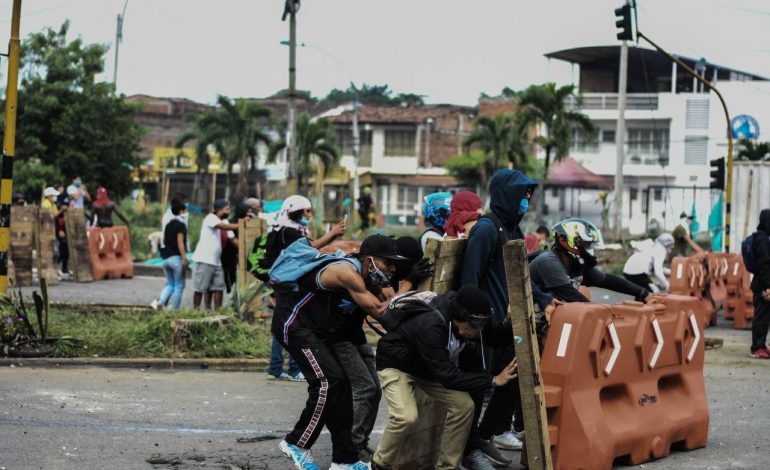 The masses need leadership up to the task / Image fair use
The masses need leadership up to the task / Image fair use
None of this has managed to subdue the movement or make it lose the enormous sympathy it has among the general population. It is impressive, heroic, and worthy of admiration. In addition, it has already won some important concessions. I am not totally familiar with the political history of Colombia, but I do not recall any movement in which the government, least of all a right-wing government as tough as that of Duque, was forced to withdraw the tax reform. Yes, they will try to put it through again in another way, but they withdrew it. They also formally withdrew the "health reform" bill. Two ministers have fallen by the force of the movement, which continues. It has become endowed with quite advanced elements of self-defence organisations, both in the peasant-indigenous Minga as well as the Primera Línea (Front Line), organised by the youth, which is at the forefront of this movement.
But, as in Chile and Ecuador, what is lacking in Colombia is a revolutionary leadership that is up to the task. Even the National Strike Committee, after the first day of strike on 28 April, called on the mobilised people to stay at home, using the excuse of the pandemic, and held a virtual May Day, which was totally ignored by the population in struggle, by the youth, the workers, the peasants, the indigenous people.
This is a mass movement but, in the absence of a revolutionary leadership, we cannot rule out that it will enter a phase of exhaustion and fatigue, especially due to the lack of perspectives. Where do we go? How do we move forward? Nobody is raising these questions in a clear way. It is also possible that this movement will finally be channeled through the electoral path of the presidential elections next year.
We have been raising a series of slogans about what we think should be done: a national emergency meeting, the organisation of popular assemblies, the election of delegates, the organisation of self-defence, turning the national strike into a truly general strike. Because it must be said: the national strike consists of roadblocks, occupation of public squares, taking over territory, but it has not really turned into a general strike of production beyond some specific sectors and at certain specific moments. A general strike would have the power to bring the country to a halt and overthrow the government and that has not been the case yet.
In any case, at the moment our forces are small and our voice is heard very little, relative to the movement as a whole. But no matter how it ends, this movement will have already left a historical mark in the revolutionary history of Colombia and in the development of the consciousness of the masses.
A continental and world process of revolution
What has happened in Colombia is not something isolated, it is exactly the same as what happened in Ecuador and Chile. The same conditions have led to the same results, with their national peculiarities. With its distinctive features. But the same conditions of attacks on the working class, of accumulation of discontent, have caused a social explosion. I would say that these conditions exist to one degree or another in most Latin American countries.
Of course, not all countries have the same government, not all countries have the same conditions, nor the same recent experience of the masses. But it is also true that the working class and the youth learn. In one country they learn from the mobilisations of another country. Why was Primera Línea formed in Colombia? Because Primera Línea was formed in Chile previously. Why was Primera Línea formed in Chile? Because the indigenous guard was formed in the mobilisations in Ecuador. This, combined with the need of the struggling masses to defend themselves from repression. But there is no doubt that this factor of inspiration played a role in accelerating the learning process. The masses learn from those experiences.
An article in the Financial Times, a newspaper that is the mouthpiece for the more far-sighted sector of the bourgeoisie in Britain, said that this uprising in Colombia is the direct result of, or has been immediately provoked by, the attempt to introduce tax reform. That is to say, due to the fact that the government has spent a significant amount of money in relation to the gross domestic product to alleviate the effects of Covid and now it wants to make the working-class and the middle layers pay for it. This has caused the uprising. And the Financial Times said that these conditions are not unique to Colombia, but are those of all of Latin America.
In all these countries we have seen a huge increase in public spending and therefore an increase in the deficit. This, coupled with a substantial increase of the public debt, in an attempt to save capitalism, is going to become a point of struggle in the next period. The Financial Times said that this can happen in other countries as well, and mentioned two in particular: Ecuador and Brazil. These are two countries where they believed an uprising of this type could take place. It is not ruled out. In this case, I agree with the most astute analysts of the bourgeoisie that these uprisings are possible in other countries and doubtlessly in the two that they mention.
Youth and women at the forefront of the revolutionary movement
The last point is that, in all these mobilisations, we have seen another common characteristic: the role of youth and the role of women in a very prominent way. Who started the movement in Chile? High school students, and more specifically female high school students. Who is playing a leading, vanguard role in the national strike in Colombia? The youth. Young people, who have nothing to lose because they have nothing. They are young people from the working-class neighbourhoods, who are not studying, who do not have a job because the little informal employment that existed, through which they survived, no longer exists due to the pandemic. They have nothing to lose and that also gives lends endurance to the movement, because where are these young people going to go? Nowhere. And now at least they are fighting and have become the inspiration of the general population.
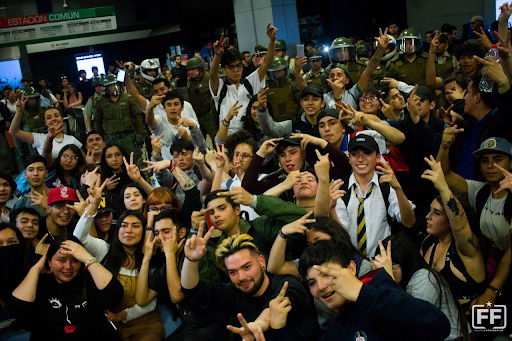 Youth, and young women especially, have been at the forefront of these struggles / Image: Frente Fotografico
Youth, and young women especially, have been at the forefront of these struggles / Image: Frente Fotografico
This generation of young people, who are now between 15 and 25 years old, have lived their entire lives under the capitalist crisis. They have not lived through the "progressive governments" of the first decade of the century. Either they weren't born yet, or they weren't politically conscious. They have come to the world consciously and politically with the crisis of 2008, which hit the hardest in Latin America, starting in 2013-14. And now they are being hit by this pandemic crisis.
This is an international phenomenon. A youth that throughout the world reflects this strong radicalisation, not only in Latin America but also in the US, where it was this youth who were at the forefront of the Black Lives Matter movement. This is the youth at the forefront of the mobilisation of the Palestinian masses in Israel. This is the youth moving everywhere towards seeking a revolutionary way out.
And along with this we have seen massive mobilisations for the right to abortion, against sexist violence against women and femicides, in which young women have been at the forefront.
We are trying to study and learn from these experiences in Ecuador, Chile, and Colombia, not for the intellectual pleasure of knowing more and being able to analyse events, but to be able to intervene. Lenin would say that, without revolutionary theory there is no revolutionary movement. The two things are closely linked. It is not only about interpreting the world, but about transforming it.
Because in all these processes, the crucial question, which is revealed most acutely, is that of the absence of a revolutionary leadership that can provide a way out of this situation of confrontation between the classes, of such great social polarisation. You cannot ask more from the working class or the youth. They have given impressive examples of heroism, in Ecuador, in Chile, in Colombia now. What is required is to build a revolutionary alternative firmly based on the ideas and methods of Marxism in order to lead our class to victory in one country or another, and that would have an impact throughout the entire continent and throughout the world.
Our forces are still modest in relation to this objective, therefore we must have a sense of urgency when building the International Marxist Tendency. Our task is clear, to build a revolutionary leadership capable of leading the working class to victory and to put an end once and for all to this capitalist regime of oppression, of violence, of misery, and to build a world worth living in.

